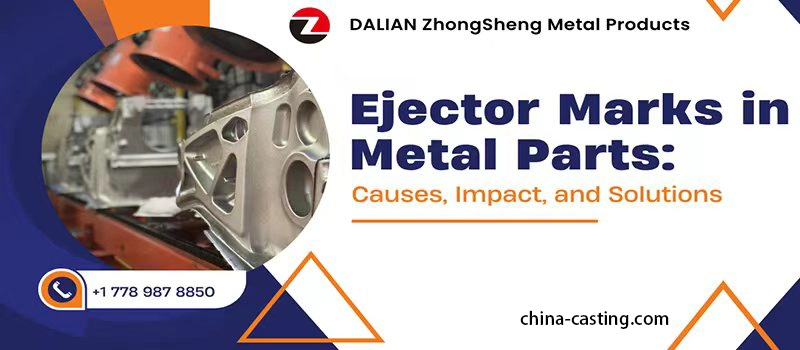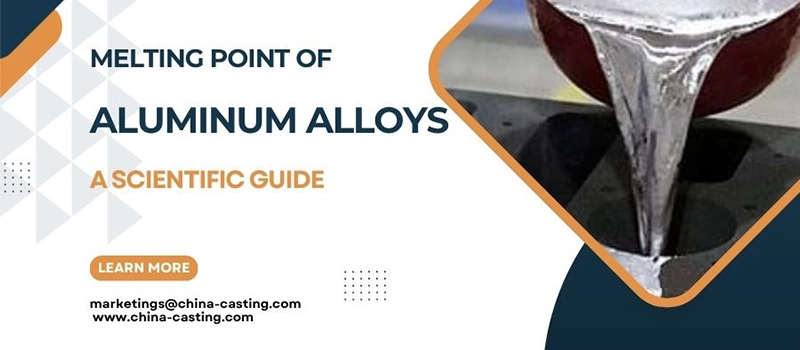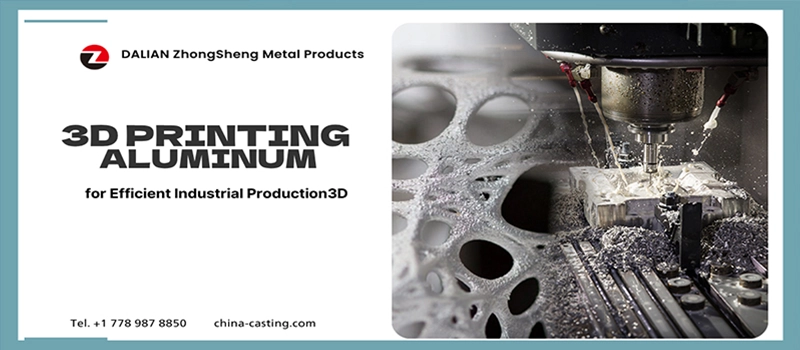What’s the difference between hot and cold forging? Why are forged parts stronger than cast or machined components? Is the forging manufacturing process still cost-effective in 2025? How do you know which forging method is best for your product?
The forging manufacturing process is where raw metal meets heat, force, and precision—transforming simple billets into components with exceptional mechanical properties. Forging isn’t just a shaping method; it’s a strength-enhancing solution that aligns grain flow, eliminates porosity, and increases impact resistance. From automotive parts to mining equipment, forged products consistently outperform their cast or machined counterparts in durability, toughness, and reliability.
This article breaks down everything you need to know about the forging manufacturing process—step by step—with expert insight from a real manufacturer. Whether you’re sourcing forged parts or looking to optimize your current production, this guide is your gateway to mastering one of the most essential processes in industrial metal fabrication.
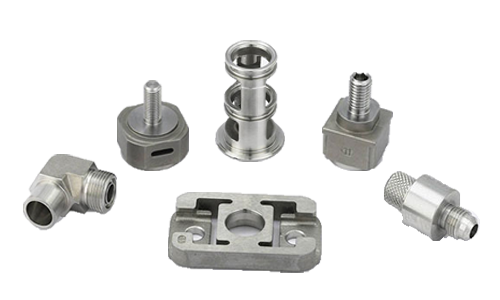
Get a quote now!
What Is the Forging Manufacturing Process?
Definition of the Forging Process
The forging manufacturing process is a high-pressure metal forming technique used to shape raw metal into strong, durable, and precisely defined parts. In its simplest form, forging involves the application of compressive force—either by hammering, pressing, or rolling—to plastically deform metal into a desired shape. Unlike other manufacturing processes that may involve melting, casting, or cutting away material, forging refines the internal grain structure of the metal, enhancing strength, toughness, and resistance to fatigue.
In modern industrial settings, the forging manufacturing process is widely used to produce high-performance components that must withstand extreme loads, impact, and stress—such as crankshafts, gears, flanges, and connecting rods. Whether executed through hot forging, cold forging, or open die and closed die methods, this process remains one of the most trusted techniques for achieving mechanical superiority in metal parts.

Key Characteristics of Forged Products
What sets forged parts apart from those produced by casting or machining? The answer lies in the microstructure. During forging, the grain flow of the metal follows the contours of the part, creating seamless transitions and reducing internal voids. This makes forged products significantly more resistant to impact, fatigue, and shearing. In industries like aerospace, automotive, and petrochemical, where failure is not an option, these structural advantages are critical.
Another hallmark of the forging manufacturing process is dimensional accuracy. With the help of advanced dies and CNC-assisted forging presses, manufacturers can now produce forged parts with tight tolerances, complex shapes, and minimal material waste. Combined with heat treatment and post-forging machining, forged components are ready for high-precision applications with minimal finishing required.
Forging vs. Other Metalworking Techniques
You might be wondering: how does forging compare to other metal forming or manufacturing methods?
- Casting involves pouring molten metal into molds. It’s great for intricate shapes but tends to introduce internal porosity and weaker grain structure.
- Machining carves parts out of a solid block. While precise, it wastes more material and lacks the grain alignment forged parts benefit from.
- Fabrication (like welding and cutting) is suitable for large structures, but not for high-load performance components.
In contrast, the forging manufacturing process is the only method that aligns internal grain flow with the part geometry—producing unmatched strength and durability. This is why forging is still the preferred choice in industries requiring components with long life cycles, structural integrity, and cost-efficiency over time.
The History and Evolution of Forging
Forging in Ancient Civilizations
The forging manufacturing process has roots that stretch back thousands of years. In ancient times, blacksmiths and metalworkers used manual tools and open fires to heat and shape metal into tools, weapons, and armor. These early artisans relied on instinct, experience, and muscle, hammering glowing metal on anvils using tongs and rudimentary hammers. Materials like bronze and wrought iron were commonly forged by hand, creating items that were both functional and symbolic of craftsmanship and status.
As early as 4000 B.C., forging was practiced in Mesopotamia and Egypt. The development of the iron age only accelerated its spread, with blacksmithing becoming central to many cultures’ economies and militaries. While primitive compared to today’s standards, these ancient forging methods laid the foundation for what would evolve into a highly engineered process in the modern world.
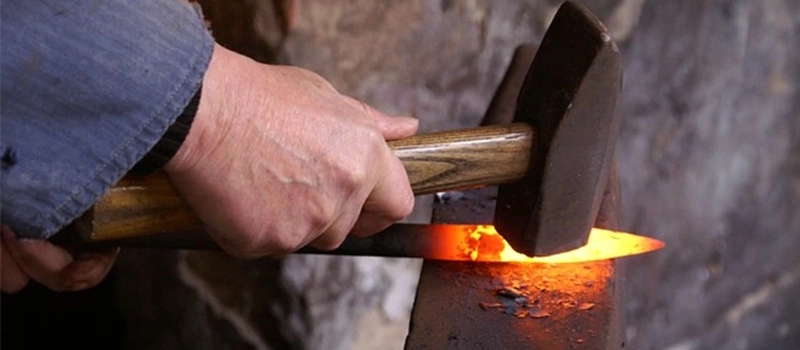
Industrial Revolution and Mechanized Forging
The dawn of the Industrial Revolution in the 18th and 19th centuries brought radical change to the forging industry. As steam power and mechanized tools became more common, manual hammering gave way to powered drop hammers, mechanical presses, and steam forging machines. This transition marked the first time forging could be scaled for mass production—fueling demand from the rail, shipbuilding, and early automotive sectors.
For the first time, metal parts could be standardized and produced in high volumes, with consistent strength and shape. Forging shops evolved into foundries and industrial plants. Steel gradually replaced iron as the material of choice, and the forging manufacturing process became a pillar of modern manufacturing.
Forging dies became more advanced, allowing for closed die forging, press forging, and upset forging to emerge as standard practices. These innovations brought not only increased efficiency but also greater control over part accuracy and mechanical properties.
Modern-Day Forging Technologies
Today, the forging manufacturing process is a highly sophisticated blend of science, software, and precision machinery. Computer-aided design (CAD) and simulation software now assist in die design and process planning, minimizing defects before production begins. Automation and robotics reduce human error, increase throughput, and improve workplace safety.
Materials science has also evolved. Forging is no longer limited to steel and iron; high-performance alloys such as titanium, aluminum, and Inconel are forged for aerospace, automotive, and defense applications. Isothermal forging, warm forging, and closed-loop control systems enable tighter tolerances, smoother finishes, and enhanced energy efficiency.
Even sustainability is now part of the picture. Modern forging operations aim to reduce waste and recycle heat, materials, and lubricants wherever possible. This positions forging not just as a legacy process—but as a forward-looking, future-proof solution for metal part manufacturing.
In short, forging has evolved from a blacksmith’s fire to a digitally controlled, high-tech process—one that continues to shape the world’s strongest components.
Types of Forging Processes in Manufacturing
The forging manufacturing process is not a single technique, but a diverse family of methods used to shape metal. The specific process selected depends on the part’s geometry, the material used, the desired mechanical properties, production volume, and cost targets. Below, we’ll break down the most widely used forging types, categorized by die configuration, temperature range, and equipment used.
Classification by Die Configuration
Need Help? We’re Here for You!
Open Die Forging Process
Open die forging—sometimes called free forging—is one of the oldest forms of the forging manufacturing process. In this method, the heated metal is placed between flat or contoured dies that do not enclose the workpiece entirely. The metal is deformed through repeated blows or compression until the desired shape is achieved.
Open die forging is ideal for:
- Large, simple-shaped parts (like shafts or rings)
- Low- to medium-volume production
- Applications requiring excellent mechanical properties and structural integrity
Its advantages include improved grain flow, minimal material waste, and the ability to forge large components up to several tons in weight. However, precision is limited compared to closed die forging, and secondary machining is often required.
Closed Die Forging Process
Also known as impression die forging, closed die forging involves placing metal between two dies that contain a pre-cut impression of the desired shape. As force is applied, the metal flows to fill the cavity, taking the exact form of the die.
This process allows for:
- Complex, high-precision geometries
- High-volume production runs
- Excellent repeatability and consistency
Because the dies are custom-engineered, the upfront cost is higher, but the long-term efficiency and reduced machining make closed die forging ideal for automotive, aerospace, and tool industries.
Impression Die and Ring Rolling Forging
- Impression Die Forging is essentially another name for closed die forging with tighter tolerance control and multi-directional material flow. It’s used when part geometry is intricate.
- Ring Rolling involves a pre-formed ring being rolled into a larger diameter and thinner cross-section. This method is perfect for bearings, flanges, and large seamless rings used in aerospace or wind energy applications.
Classification by Temperature
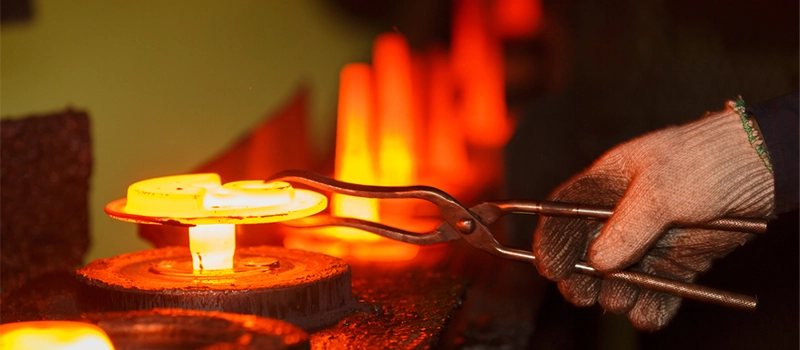
Hot Forging Process
In the hot forging process, the metal is heated above its recrystallization temperature (typically 1,100°C for steel). This softens the material and reduces the required forming force, allowing for easy shaping and excellent grain refinement.
Benefits of hot forging:
- Excellent ductility and formability
- Ideal for complex shapes
- Strong final product due to optimal grain structure
Hot forging is the most common form of the forging manufacturing process in heavy industries.
Cold Forging Process
Cold forging is performed at or near room temperature. While it requires much higher force, it results in smoother surface finishes, tighter dimensional control, and work-hardened parts.
Ideal for:
- Fasteners like bolts and screws
- High-speed production lines
- Parts requiring minimal post-processing
Cold forging is energy-efficient but limited to simpler geometries and softer materials.
Warm Forging Process
Warm forging occurs between cold and hot forging temperatures—usually between 500–800°C. It balances the ease of hot forging with some benefits of cold forging, such as:
- Improved surface finish
- Less die wear
- Lower forming force than cold forging
It’s often used in automotive components and precision parts where a good surface finish and near-net shape are required.
Classification by Equipment Used
Drop Forging Process
In drop forging, a hammer is dropped onto the workpiece (usually in a die) to deform it into the desired shape. It’s fast, cost-effective, and widely used in automotive, agricultural, and hardware tools manufacturing.
Two types:
- Open die drop forging
- Closed die drop forging
Drop forging is known for high production rates and good dimensional accuracy.
Press Forging Process
Press forging uses a slow, steady pressure—usually via hydraulic or mechanical presses—to shape the metal. Unlike impact-based methods, press forging allows the entire part to be deformed at once.
Advantages:
- Better control over metal flow
- Can handle large, thick parts
- Excellent internal structure with minimal voids
Ideal for precision components where grain structure and strength are critical.
Upset Forging Process
Upset forging increases the diameter of a metal piece by compressing its length. Think of a bolt head being formed—this is upset forging.
Commonly used for:
- Fasteners (bolts, rivets)
- Engine valves
- Axle components
Upset forging is often automated and used in high-volume production lines.
Roll Forging Process
In roll forging, a round or flat bar is passed through two opposing rollers to gradually reduce its thickness and increase its length. It’s used to form tapered shafts, levers, and connecting rods.
Key benefits:
- High-speed, continuous production
- Minimal waste
- Good surface finish
The right type of forging depends on your specific production needs—whether it’s shape complexity, material strength, tolerance, or volume. Understanding these types of forging processes ensures better supplier selection, cost estimation, and long-term performance of the finished part.
Step-by-Step Breakdown of the Forging Manufacturing Process
The forging manufacturing process is a controlled series of steps that transforms raw metal stock into a finished, high-strength component. Whether the method is open die, closed die, or cold forging, the fundamental sequence follows a similar path — starting with raw material preparation and ending with final inspection.
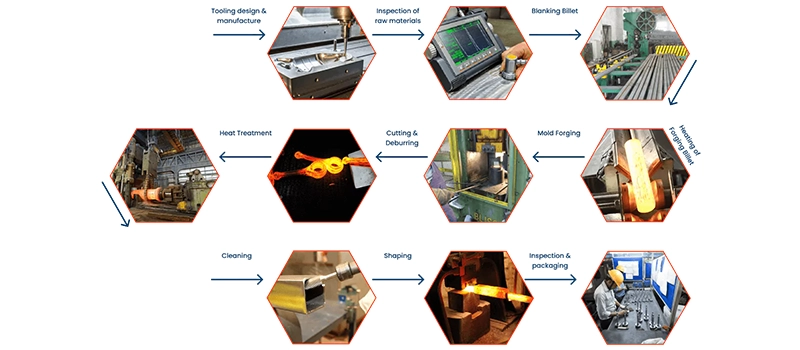
Here’s a detailed look at each stage of the process:
Step 1 – Raw Material Selection and Cutting
Everything begins with the right raw material. The chosen metal—whether steel, aluminum, titanium, or copper—is selected based on the mechanical properties required for the finished product. Considerations include tensile strength, ductility, corrosion resistance, and temperature tolerance.
The material is typically supplied in bar, billet, or rod form. Precision cutting equipment (such as band saws or shearing machines) is used to segment the metal into manageable workpieces, also called slugs or blanks.
Tip: The accuracy of this cut affects not only part quality but also material usage and tooling wear downstream.
Step 2 – Preheating (For Hot and Warm Forging Only)
In hot forging processes, the cut billet is heated to its recrystallization temperature to make it more malleable. This softens the material and promotes grain refinement. Heating methods include:
- Induction heaters
- Gas furnaces
- Electric resistance furnaces
Temperatures can vary:
- Steel: 1,100°C to 1,250°C
- Aluminum: 400°C to 500°C
- Titanium: ~950°C
In warm forging, the temperature is lower (between 500°C and 800°C), offering a balance between formability and reduced oxidation.
Cold forging skips this step entirely, as it occurs at or near room temperature.
Step 3 – Die Setup and Lubrication
In closed die forging, upper and lower dies are precision-machined to the exact shape of the final part. These dies are mounted onto the press or hammer system.
Before the forming begins, lubricants (like graphite-based or oil-based compounds) are applied to:
- Reduce friction
- Minimize die wear
- Facilitate metal flow
- Ease part ejection
In open die forging, flat or contoured anvils are used instead, offering more flexibility for larger components.
Step 4 – Forging Operation (Forming the Shape)
This is the heart of the forging manufacturing process. The heated or cold billet is placed between the dies or under the hammer/press. Controlled force is applied to deform the metal into its final or near-net shape.
Depending on the process, this can happen via:
- Repeated hammering (drop forging)
- Steady pressing (press forging)
- Rolling (roll forging)
Key advantages at this stage:
- Aligned grain flow with the part’s geometry
- Elimination of internal voids
- Strengthening through plastic deformation
Need Help? We’re Here for You!
Step 5 – Flash Removal and Trimming
In closed die forging, excess metal—called flash—is squeezed out around the edges. This flash is later trimmed using precision dies or mechanical shears.
Flash removal ensures:
- Clean part contours
- Accurate dimensions
- Reduced machining effort in finishing
This step may not apply to open die forging or precision near-net forging methods.
Step 6 – Heat Treatment or Normalizing
Forged components often require post-process heat treatment to:
- Improve hardness
- Relieve internal stress
- Enhance wear resistance
- Stabilize dimensions
Common treatments include:
- Annealing
- Quenching and tempering
- Normalizing
- Solution treatment (for aluminum alloys)
These treatments refine microstructure and further improve mechanical properties, especially for aerospace or load-bearing applications.
Step 7 – Surface Cleaning and Finishing
After forging and heat treatment, parts may undergo cleaning and finishing to remove scale, oxides, or surface roughness. Typical methods include:
- Shot blasting
- Pickling
- Grinding
- CNC machining (for tight tolerance areas)
If the part is a critical component, high-precision machining might follow to ensure perfect dimensions.
Step 8 – Final Inspection and Quality Control
No forged part is complete without rigorous inspection. Quality assurance measures ensure the component meets dimensional, mechanical, and visual standards.
Common inspection techniques:
- Dimensional inspection (calipers, gauges, CMM)
- Non-destructive testing (ultrasonic, dye penetrant, magnetic particle)
- Mechanical testing (tensile, hardness, impact tests)
- Surface roughness testing
Documentation, certifications (like ISO or CE), and lot traceability are also part of the final handover, especially for critical-use parts in aerospace, automotive, or defense sectors.
In summary, each step in the forging manufacturing process plays a critical role in producing parts that are not just shaped—but strengthened from the inside out. Mastery of this process enables manufacturers to deliver components that offer superior performance under pressure, wear, and time.
Materials Used in the Forging Process
The choice of material plays a defining role in the success of any forging manufacturing process. It affects not only the forging temperature and the complexity of the shaping operation but also the final product’s mechanical strength, fatigue life, corrosion resistance, and cost.
Each forging material offers unique benefits, making certain alloys more suitable for specific industries or applications. Below, we’ll explore the most commonly used metals in forging, divided into ferrous and non-ferrous categories.
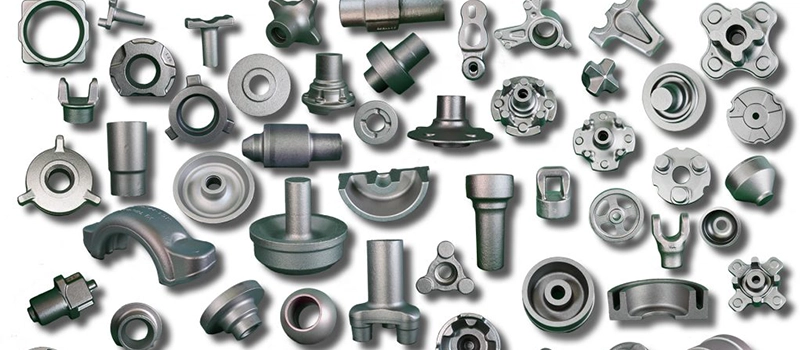
Ferrous Metals in Forging
Carbon Steel
Carbon steel is the most frequently used material in forging due to its excellent strength-to-cost ratio. Available in low, medium, and high carbon content, it covers a wide range of applications from structural parts to automotive components.
- Low carbon: Easy to forge, ductile, but lower strength
- Medium carbon: Balanced hardness and ductility
- High carbon: Hard and wear-resistant, ideal for tools
Applications: crankshafts, gears, spindles, axles, bolts
Alloy Steel
Alloy steels are carbon steels enhanced with elements like chromium, nickel, molybdenum, and vanadium. These additions increase toughness, corrosion resistance, and heat resistance.
Common grades used in the forging manufacturing process include:
- 4140 (chromium-molybdenum steel)
- 4340 (nickel-chromium-molybdenum)
- 8620 (case-hardening steel)
Applications: aerospace parts, high-performance automotive parts, tools
Stainless Steel
Stainless steel contains at least 10.5% chromium, making it highly resistant to corrosion. It’s more difficult to forge than carbon steels due to its higher strength and lower thermal conductivity, but it’s essential for hygienic or harsh-environment applications.
Types include:
- Austenitic (non-magnetic, high corrosion resistance)
- Martensitic (harder, used in knives/tools)
- Ferritic (magnetic, moderate corrosion resistance)
Applications: valves, fittings, food processing forgings, surgical instruments
Need Help? We’re Here for You!
Non-Ferrous Metals in Forging
Aluminum and Aluminum Alloys
Aluminum is light, corrosion-resistant, and offers excellent workability—making it ideal for cold forging processes or near-net shape production. Alloys like 6061, 6082, and 7075 are popular in aerospace and automotive industries.
Benefits:
- High strength-to-weight ratio
- Non-magnetic and conductive
- Excellent corrosion resistance
Applications: aircraft components, heat sinks, suspension parts, electronic enclosures
Copper and Brass
Copper and its alloys (like brass and bronze) are valued for their thermal and electrical conductivity, ductility, and corrosion resistance. Forging copper typically requires lower temperatures, making it suitable for precision press forging.
Applications:
- Electrical connectors
- Plumbing fixtures
- Decorative hardware
Titanium and Nickel-Based Alloys
Titanium offers unmatched corrosion resistance and strength-to-weight ratio, but it’s more challenging and costly to forge. It requires isothermal forging or specialized die materials due to its narrow processing window.
Nickel alloys (like Inconel) are essential in aerospace and high-temperature environments, where other metals would degrade.
Applications: aircraft engine components, turbine blades, medical implants
Material Selection Based on Application
Choosing the right material for the forging manufacturing process depends on a variety of factors:
- Mechanical requirements: load-bearing, impact resistance, fatigue life
- Environmental factors: exposure to heat, moisture, or chemicals
- Formability: how easily the material can be deformed under pressure
- Cost constraints: material availability, post-forging operations
- Regulatory needs: compliance with CE, ISO, ASTM, or aerospace standards
Forging suppliers often assist clients with selecting the proper alloy based on the application and the desired performance characteristics of the finished component.
In short, material selection is not just a starting point—it’s a strategic decision that determines the part’s success in the field. Understanding how different metals behave in the forging manufacturing process is key to maximizing product value and minimizing downstream issues.
Tools and Equipment in Industrial Forging
Behind every high-performance forged part lies a sophisticated set of machines, dies, and handling systems. In the modern forging manufacturing process, efficiency, safety, and precision all depend on the proper selection and use of forging tools and equipment.
Let’s break down the essential categories of equipment used across various forging processes.
Forging Hammers and Presses
These machines provide the force needed to deform the metal into its final shape. They are the core drivers of the forging process, and the choice between them depends on the type of forging and desired output.
Drop Hammers
- Use gravitational or powered force to rapidly strike the workpiece
- Common in open die and closed die forging
- Ideal for producing high volumes of parts with medium to high complexity
Types:
- Board drop hammers
- Air-lift hammers
- Steam hammers
Mechanical Presses
- Use cams, cranks, or toggles to convert rotary motion into linear pressing force
- Provide faster cycle times than hydraulic presses
- Widely used in cold forging processes and high-volume precision forging
Hydraulic Presses
- Apply slow, steady pressure—excellent for closed die forging or large parts
- Ideal for producing parts with complex geometry and tight tolerances
- Can exert forces up to 100,000 tons for massive industrial components
Screw Presses
- Offer controlled deformation by rotating a screw ram
- Provide high energy in a short stroke
- Best suited for smaller parts requiring a precise finish
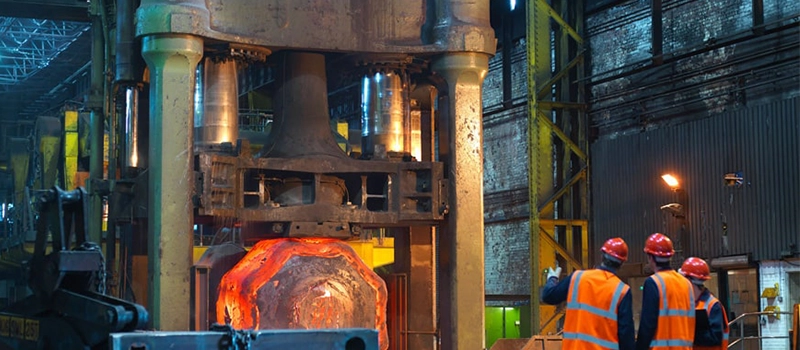
Dies and Molds
Dies are the tools that shape the metal. In closed die forging, they contain impressions (cavities) that the metal fills during deformation. Proper die design is essential to ensure part integrity, efficiency, and material flow.
Types of dies:
- Flat dies: Used in open die forging
- Impression dies: Used in closed die or precision forging
- Trimming dies: Used to remove flash or excess material after forging
- Heading dies: Common in bolt or fastener forging
Materials:
- Usually made from H13 or H21 tool steel
- Treated with coatings (e.g., nitriding) for heat and wear resistance
High-precision die design using CAD/CAM tools allows for optimized material flow, reduced defects, and longer die life.
Heating Equipment
Heating is crucial in hot and warm forging processes, where the billet must reach specific temperatures before deformation.
Induction Furnaces
- Fast, precise, and energy-efficient
- Ideal for medium- to high-volume forging lines
Gas or Oil-Fired Furnaces
- Used in heavy industrial forging
- More suited for larger billets or open die operations
Electric Resistance Furnaces
- Used for preheating dies or small-batch billet heating
Temperature control is critical—too hot and the metal may burn or scale; too cold and it may crack or resist deformation.
Need Help? We’re Here for You!
Lubrication and Cooling Systems
Friction between the workpiece and the die can lead to heat buildup, excessive wear, and part defects. That’s where lubrication and cooling come in.
Functions of lubricants:
- Minimize friction between metal and die
- Reduce die wear
- Help with part release
- Improve surface finish
Common lubricants:
- Graphite-based lubricants (used in hot forging)
- Oil-based emulsions (used in cold forging)
Spray systems or robotic arms may apply lubricant automatically during high-speed production.
Material Handling Systems
Safety and efficiency are paramount in modern forging environments. Handling equipment helps move heavy billets, transfer hot parts, and maintain consistent production flow.
Common systems include:
- Conveyor belts
- Manipulators and transfer arms
- Robotic loaders/unloaders
- Rotary indexing tables
In automated forging lines, material handling is often fully synchronized with the press cycle to maximize output and reduce downtime.
The success of any forging manufacturing process relies not only on the material and method—but on the quality and compatibility of its equipment. Choosing the right machinery and maintaining it properly ensures consistent part quality, tool life, and production speed.
Advantages of the Forging Manufacturing Process
The forging manufacturing process is widely regarded as one of the most reliable and performance-driven methods in modern metalworking. Unlike casting or machining, forging uses force and pressure to shape metal while refining its internal structure — giving forged parts superior mechanical properties, dimensional consistency, and long-term durability.
Here’s why manufacturers across automotive, mining, construction, and aerospace industries continue to rely on the forging manufacturing process.
Superior Mechanical Properties
Forged components are stronger than those made by any other metal forming process. This is due to the way the forging manufacturing process aligns the metal’s grain structure with the shape of the part. Grain flow follows the contours of the component, eliminating weak points and significantly increasing:
- Tensile strength
- Fatigue resistance
- Ductility and toughness
- Shock and impact absorption
In applications like crankshafts, gears, or pressure valves — where failure is not an option — these mechanical advantages make forging the clear choice.
Improved Structural Integrity
The forging manufacturing process virtually eliminates internal porosity, shrinkage, and gas pockets, which are common in casting. Because the material is compressed and deformed under extreme pressure (especially in closed die or hot forging), forged parts show superior structural integrity and performance reliability in high-stress environments.
In safety-critical industries such as oil & gas or aerospace, forged components are often the only acceptable option.
Exceptional Dimensional Accuracy and Surface Finish
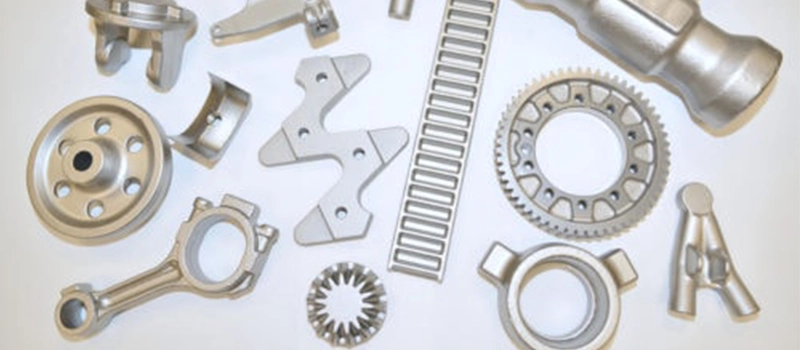
Thanks to modern tooling and die design, the forging manufacturing process can achieve near-net shapes with tight tolerances. This reduces the need for costly secondary machining.
- Cold forging and precision forging can produce parts with minimal surface finishing
- Surface integrity is maintained due to clean deformation (rather than material removal)
- Complex geometries can be achieved using multi-cavity dies and simulation-aided design
Forging reduces the variability between parts, which is crucial in industries that demand interchangeability and consistency across high-volume production runs.
High Production Efficiency
For high-volume manufacturing, the forging manufacturing process offers unmatched efficiency:
- Short cycle times (especially with mechanical presses and automated handling systems)
- Consistent, repeatable part quality
- Long die life when properly maintained
- Minimal material waste compared to machining
The repeatability of closed die forging makes it especially cost-effective for OEM production, while open die forging is ideal for low-volume, custom components.
Versatility Across Materials and Applications
The forging manufacturing process can be applied to a wide range of metals including:
- Carbon and alloy steels
- Stainless steel
- Aluminum and copper alloys
- Titanium and nickel-based superalloys
This versatility makes forging suitable for an equally broad spectrum of parts, such as:
- Bolts, shafts, and gears
- Flanges, couplings, and valves
- Wheel hubs, axles, and suspension arms
- Blades, rings, and fasteners
Whether you’re producing lightweight components for aerospace or rugged parts for mining machinery, forging delivers consistent performance in any environment.
Long-Term Cost Benefits
Although the initial tooling cost of the forging manufacturing process (especially for closed die systems) can be higher, the long-term cost-per-part is often significantly lower. This is due to:
- Reduced raw material waste
- Fewer machining operations
- Lower scrap rates
- Extended service life of forged parts
- Minimal maintenance and failure replacement in end-use
In industries where downtime equals lost revenue, the reliability of forged components offers measurable ROI.
In conclusion, the forging manufacturing process offers a winning combination of strength, precision, and efficiency. It’s not just a legacy method — it’s a future-proof manufacturing solution that supports today’s high-performance industries with consistent, reliable results.
Applications of Forged Components Across Industries
The forging manufacturing process is trusted worldwide for producing components that must perform under pressure—literally. Forged parts are essential in industries that demand strength, reliability, and long service life, often in extreme conditions. From automotive engines to offshore drilling rigs, forged components are everywhere, forming the backbone of modern industry.
Below, we’ll explore how the forging manufacturing process serves a variety of sectors and the types of forged products commonly used in each.
Automotive Industry
In the automotive sector, safety, speed, and performance all depend on component strength and precision. That’s why the forging manufacturing process is extensively used to produce critical parts that must endure repeated loads, high heat, and continuous motion.
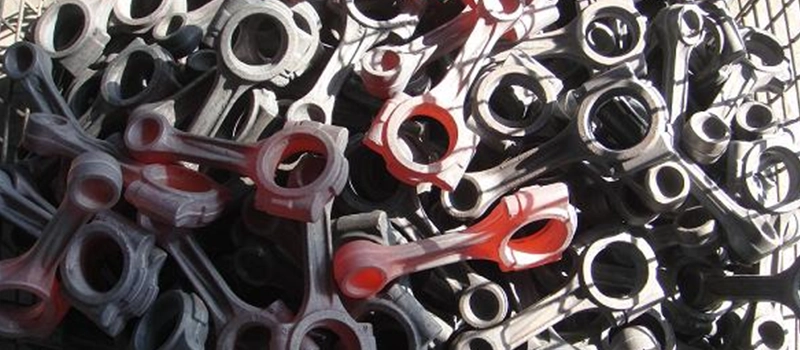
Common automotive forged parts:
- Crankshafts
- Connecting rods
- Axles and shafts
- Wheel hubs
- Gears and transmission components
- Tie rods and suspension arms
Forging ensures these parts have excellent fatigue resistance, tight dimensional tolerances, and optimized grain flow for high RPM and torque applications.
Aerospace and Defense
Aerospace applications push materials to the limit—requiring lightweight yet high-strength parts that won’t fail under extreme stress or temperature fluctuations. The forging manufacturing process is essential for parts that must withstand high altitude pressure, engine heat, and combat conditions.
Typical aerospace and defense forged parts:
- Landing gear components
- Engine turbine disks
- Structural brackets
- Missile and rocket parts
- Jet engine shafts and compressor blades
Titanium and high-performance nickel alloys are often forged using precision and isothermal forging methods for maximum performance with minimal weight.
Oil, Gas, and Petrochemical Industries
Forged components are vital in oil and gas applications where equipment must operate in corrosive, high-pressure, and explosive environments. The forging manufacturing process provides the strength, sealing reliability, and material integrity needed in these critical systems.
Examples of forged components:
- High-pressure flanges
- Valve bodies
- Pipe fittings and elbows
- Wellhead equipment
- Blowout preventers
These parts often require additional heat treatments and surface coatings, which pair well with the robust microstructure created by forging.
Mining, Construction, and Agriculture
In heavy-duty industries like mining, construction, and agriculture, equipment parts take a beating every day. Whether it’s digging, crushing, or hauling, components must resist impact, wear, and bending forces.
The forging manufacturing process is used to produce:
- Hydraulic cylinder components
- Bucket teeth and cutting edges
- Track links and pins
- Drive shafts and couplings
- Shovels, picks, and blades
Forged parts last longer and reduce downtime, helping improve productivity and reduce maintenance costs in rugged work environments.
Railway and Transportation
Railways rely on forged parts for their ability to handle vibration, temperature variation, and immense weight. Forging ensures excellent fatigue life and resistance to deformation in components that operate 24/7.
Common forged railway parts include:
- Train axles
- Wheels and bearing housings
- Brake parts
- Couplers and yokes
The forging manufacturing process allows for bulk production of these parts while maintaining tight dimensional and performance standards.
General Industrial and Mechanical Applications
Forging is also widely used in general manufacturing, machinery building, and tool production. In these applications, forged parts are prized for their strength-to-weight ratio, resistance to shearing and breaking, and excellent machining compatibility.
Examples:
- Hand tools (wrenches, hammers, pliers)
- Industrial gears and sprockets
- Machine tool components
- Piston rods and spindles
- Forged bolts, nuts, and fasteners
These parts benefit from the uniformity and dense microstructure only the forging manufacturing process can provide.
Across every major industrial sector, forged parts are trusted for their performance under pressure. When the cost of failure is high—whether in a high-speed jet engine or deep-sea oil rig—engineers turn to the forging manufacturing process for dependable results.

Get a quote now!
Quality Control in the Forging Manufacturing Process
In any industry, but especially in aerospace, automotive, mining, and oil & gas, part failure isn’t just costly — it’s dangerous. That’s why quality control is critical to every stage of the forging manufacturing process. From raw material inspection to final dimensional checks, quality assurance ensures that every forged component meets performance, safety, and regulatory standards.
Here’s how manufacturers maintain precision, consistency, and reliability throughout the forging production lifecycle.
In-Process Dimensional and Visual Checks
During the forging manufacturing process, real-time inspection is performed to monitor shape, size, and surface condition. Operators use tools like:
- Vernier calipers and micrometers
- Go/No-Go gauges
- Optical comparators
- Coordinate Measuring Machines (CMMs)
These tools verify whether the forged parts conform to the engineering drawing or 3D model — especially in closed die forging, where tight tolerances are essential.
Visual inspections are also carried out to check for surface defects like cracks, laps, scales, or folds that may indicate issues with die design, lubrication, or temperature control.
Surface Defect Detection and Crack Testing
Forged components are often subjected to non-destructive testing (NDT) methods to uncover internal or surface-level imperfections without damaging the part. These are crucial for safety-critical parts in aerospace, rail, and pressure systems.
Common NDT methods used in the forging manufacturing process include:
- Ultrasonic Testing (UT) – detects subsurface defects like voids or inclusions
- Magnetic Particle Inspection (MPI) – used for detecting surface and near-surface cracks in ferromagnetic metals
- Dye Penetrant Inspection (DPI) – highlights fine surface cracks on non-ferrous components
- X-ray Testing – high-resolution internal imaging for complex parts
These tests ensure that forged components are structurally sound and free of flaws that could compromise performance under stress.
Heat Treatment Validation
Post-forging heat treatment is vital for optimizing mechanical properties such as hardness, toughness, and ductility. Quality control during this phase involves:
- Monitoring furnace temperatures with thermocouples
- Ensuring correct heating/cooling cycle durations
- Recording thermal profiles for traceability
Metallurgical testing follows to validate that the forging manufacturing process has produced the intended grain structure and material phase.

Common heat treatment tests include:
- Hardness testing (Rockwell, Brinell)
- Microstructure examination via optical microscope
- Tensile strength testing for mechanical validation
Mechanical Property Testing
Beyond structural soundness, forged parts must meet the mechanical performance standards required by the application. This is especially critical in industries where fatigue, impact, and wear resistance are key.
Typical mechanical tests performed include:
- Tensile Testing – Measures ultimate strength and elongation
- Impact Testing (Charpy or Izod) – Evaluates toughness
- Fatigue Testing – Determines how the part handles cyclic loads
- Hardness Testing – Confirms resistance to deformation
The forging manufacturing process is specifically chosen for parts that must pass these tests under extreme conditions, ensuring high performance even under dynamic stress.
Certification, Documentation, and Traceability
Industrial buyers often require documentation that confirms the forged parts meet all specifications. This includes:
- Material Test Reports (MTR)
- Dimensional Inspection Reports
- NDT Certification
- CE Compliance Documentation
- ISO 9001 or IATF 16949 Quality Management Certificates
A critical part of the forging manufacturing process is ensuring full traceability — the ability to track each part back to its batch of raw material, die set, heat treatment cycle, and operator station.
Digital Quality Control Systems
Modern forging facilities now integrate digital quality management systems (QMS) that monitor and record all aspects of the forging manufacturing process. With the use of sensors, barcode tracking, and real-time dashboards, manufacturers can ensure:
- Instant detection of deviations
- Early warning for equipment wear
- Audit readiness
- Data-driven improvements for continuous quality control
These systems bring transparency and efficiency to the entire supply chain, giving buyers and engineers peace of mind.
In short, the forging manufacturing process isn’t just about shaping metal — it’s about shaping confidence. With stringent quality control protocols in place, manufacturers can consistently deliver high-performance, safety-critical components that meet — and often exceed — customer expectations and industry regulations.
Innovations and Future Trends in Forging Technology
The forging manufacturing process has come a long way from its roots in blacksmithing. Today, it’s not just about brute force and heat — it’s about precision, automation, efficiency, and sustainability. As global industries demand stronger, lighter, and more complex parts, forging continues to evolve through technological innovations that expand its capabilities and applications.
In this section, we’ll explore the most exciting advancements shaping the future of the forging industry — many of which are already being adopted by modern manufacturers.
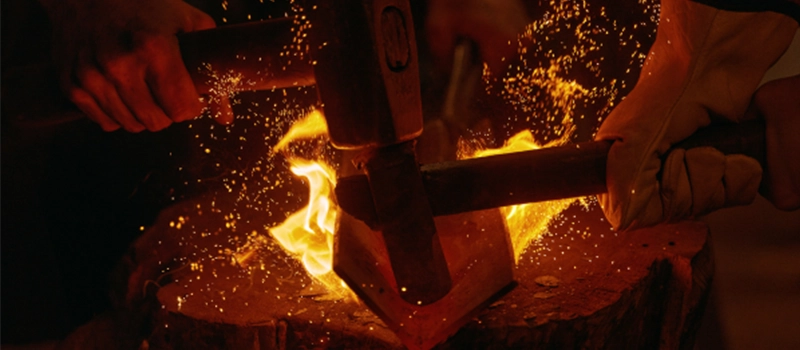
Isothermal and Precision Forging Techniques
Traditional hot forging involves significant temperature variation between the billet and the die. This can cause inconsistent material flow and dimensional inaccuracies. Enter isothermal forging — an advanced method where both the die and workpiece are maintained at the same temperature throughout the process.
Benefits of isothermal forging:
- Extremely tight tolerances
- Reduced cracking and stress
- Enhanced surface finish
- Minimal flash or material waste
This approach is especially effective in forging titanium, nickel alloys, and other difficult-to-work metals used in aerospace and defense.
Precision forging, on the other hand, uses advanced die design and process simulation to produce near-net shape parts. These require little to no secondary machining, lowering the total production cost and improving consistency.
CAD/CAM and Simulation in Die Design
The introduction of computer-aided design (CAD) and computer-aided manufacturing (CAM) has revolutionized die development in the forging manufacturing process. Designers can now simulate metal flow, pressure distribution, and die wear before any physical tooling is produced.
Benefits of simulation tools:
- Reduced development time and cost
- Elimination of design flaws early in the process
- Optimal material flow and grain structure prediction
- Better utilization of material and energy
Software like DEFORM™, QForm, and Forge® Nxt allows engineers to validate die geometry and optimize cycle parameters for the best possible outcome — all digitally.
Automation and Robotics in Forging Lines
Forging has always been physically demanding. But today, robots and automation systems are stepping in — not to replace human oversight, but to increase safety, precision, and throughput in high-speed forging operations.
Examples of automation in the forging manufacturing process:
- Robotic billet loading/unloading
- Automated lubrication systems
- Robotic flash trimming and handling
- Integrated sensor systems for quality monitoring
Automated forging cells are now common in automotive and aerospace manufacturing, where precision and repeatability are non-negotiable. They also reduce human error, improve safety, and enable 24/7 production schedules.
Data Analytics and AI for Process Optimization
With the rise of Industry 4.0, forging is becoming smarter. Real-time data collection from machines, dies, and inspection systems allows manufacturers to detect anomalies, predict maintenance needs, and optimize performance.
AI-powered systems can now:
- Predict die failure
- Recommend energy-saving process adjustments
- Optimize heating cycles based on part geometry
- Adjust lubrication patterns dynamically
This data-driven approach to the forging manufacturing process makes operations more agile and efficient, with lower rejection rates and faster troubleshooting.
Eco-Friendly Forging and Energy Efficiency
Sustainability is no longer optional. Modern forging shops are adopting greener technologies that reduce energy consumption, carbon emissions, and waste.
Eco-friendly innovations include:
- High-efficiency induction furnaces
- Closed-loop cooling systems
- Recycled lubricants and water
- Waste heat recovery for preheating billets
- Flashless forging and material-saving dies
Sustainable practices make the forging manufacturing process more cost-effective and more appealing to buyers who prioritize green supply chains.
3D Preform Modeling and Hybrid Processes
One of the most exciting developments is the use of 3D printing for preform creation, followed by traditional forging. This hybrid process combines the flexibility of additive manufacturing with the strength of forging.
Applications:
- Complex aerospace brackets
- Custom medical implants
- Lightweight automotive components
By printing near-net shape preforms and then forging them, manufacturers can reduce waste, shorten lead times, and improve grain flow in previously unforgeable parts.
The forging manufacturing process is evolving rapidly — driven by digital innovation, material science, and environmental responsibility. These breakthroughs are not only making forging more precise and efficient, but also expanding its role in high-tech industries that demand excellence at every level.
Forging vs Casting vs Machining: What’s the Difference?
When it comes to producing metal parts, engineers and buyers often face a strategic choice: should you go with forging, casting, or machining? Each method has its place in manufacturing, but they produce very different results in terms of strength, precision, cost, and efficiency.
Let’s take a closer look at how the forging manufacturing process compares with casting and machining — and when each is most appropriate.
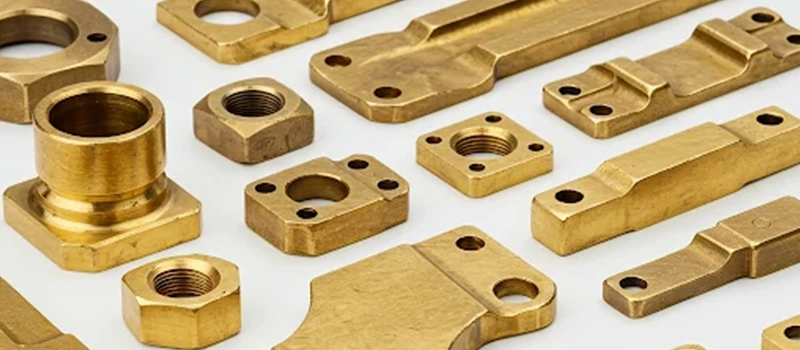
1. Strength and Structural Integrity
Forging Manufacturing Process
- Strongest option due to aligned grain flow
- Virtually no internal voids or porosity
- Excellent fatigue, shear, and impact resistance
- Ideal for high-stress or safety-critical components
Casting
- Metal is melted and poured into a mold
- Can form complex shapes but prone to shrinkage and porosity
- Weaker grain structure; less suitable for dynamic loads
- Better for intricate designs with low structural demands
Machining
- Material is cut or milled from a larger billet
- Strength depends on base material; grain flow may be interrupted
- Best for tight tolerances, not maximum strength
Verdict: The forging manufacturing process wins for mechanical strength and part durability, especially for load-bearing parts.
2. Dimensional Accuracy and Surface Finish
Forging Manufacturing Process
- Modern closed die and cold forging offer excellent dimensional control
- Surface finish is good but may require minor post-processing
- Flash trimming or machining may be needed for tight tolerances
Casting
- Can create highly complex geometries with fine surface detail
- Often requires finishing or machining to remove parting lines or defects
- Shrinkage and cooling can distort dimensions
Machining
- Highest precision and best surface finish
- Ideal for fine tolerances and smooth finishes
- However, material waste is high
Verdict: Machining leads in precision, but forging comes close with advanced tooling, and it offers better performance properties.
3. Production Efficiency and Material Waste
Forging Manufacturing Process
- High material utilization, especially in near-net shape forging
- Fast cycle times in high-volume production
- Moderate tooling investment pays off over large batches
Casting
- Good for medium to high-volume runs
- Higher scrap rates due to defects like porosity or cold shuts
- Mold wear and rework can add time
Machining
- High waste: much of the original billet is cut away
- Slower per-part cycle time
- Expensive for large-volume production due to labor and tooling
Verdict: The forging manufacturing process is far more efficient in material usage and production speed for most industrial components.

Get a quote now!
4. Tooling and Setup Costs
Forging Manufacturing Process
- Requires custom dies (especially in closed die forging)
- Higher initial cost, but low per-unit cost in high volumes
- Long die life when properly maintained
Casting
- Mold design can be expensive for precision parts
- Reusable molds lower cost over time, but quality control is an issue
- Ideal for small to medium volume with complex shapes
Machining
- Low upfront cost for prototyping
- High cost per part over time due to waste and tool wear
- Time-intensive for complex or large parts
Verdict: For long-term production, the forging manufacturing process balances tooling cost with part strength and efficiency.
5. Application Suitability
| Industry/Application | Best Process |
|---|---|
| High-load automotive parts | Forging manufacturing process |
| Intricate, decorative parts | Casting |
| Prototypes, fine-tuned gears | Machining |
| Aerospace turbine disks | Forging |
| Complex valve bodies | Casting |
| Ultra-precise tooling | Machining |
In the end, each method has its strengths — but when mechanical reliability, production speed, and long-term cost efficiency matter most, the forging manufacturing process is hard to beat.
Choosing the Right Forging Supplier
No matter how advanced the forging manufacturing process is, the quality of your final component ultimately depends on the supplier behind it. A strong forging partner doesn’t just deliver parts — they deliver performance, traceability, and peace of mind.
Here’s what you should evaluate when selecting a forging manufacturer, especially for high-stakes industrial applications.
Technical Capability and Process Range
A reputable supplier should offer a broad range of forging processes to match your technical needs, including:
- Open die forging for large custom shapes
- Closed die forging for precision and high-volume parts
- Cold forging for smooth surfaces and dimensional accuracy
- Upset forging for bolts, fasteners, and shaft ends
- Press and drop forging depending on force requirements
Ask:
- Can they handle your required part size and complexity?
- Do they have experience with the same or similar material?
- What forming forces and equipment do they use?
A good supplier will be able to adapt their forging manufacturing process to your drawings, tolerances, and specifications.
Material Traceability and Certification
Forged parts are often used in mission-critical assemblies — so material integrity must be guaranteed. Your supplier should provide complete traceability from raw material sourcing through production.
Check for:
- Mill Test Certificates (MTC) or Material Test Reports (MTR)
- CE marking and REACH/RoHS compliance (especially for EU markets)
- ISO 9001, ISO 14001, or IATF 16949 certifications
- Full batch records with heat number tracking
- EU representative compliance (if importing into Europe)
Traceability protects your project and ensures your supplier is serious about quality management in their forging manufacturing process.
Lead Time and Logistics Support
A technically competent supplier is only useful if they can meet your schedule. Ask detailed questions about:
- Typical production lead time for similar parts
- Die/mold design timelines
- Shipping methods and incoterms
- Handling of customs clearance or export documentation
- Whether they offer sea, air, or express delivery options
For global projects, an experienced supplier should understand how the entire forging manufacturing process fits into international logistics and deadlines.
Post-Forging Machining and Finishing Services
Forged parts often require secondary operations, especially when tight tolerances or complex geometries are needed. Partnering with a supplier who offers value-added services can dramatically reduce costs and coordination time.

Look for:
- CNC machining capabilities (turning, milling, drilling)
- Heat treatment in-house or through certified subcontractors
- Surface treatments (shot blasting, coating, passivation)
- Assembly or sub-assembly services
- Final inspection, packaging, and labeling
An integrated supplier can manage the complete forging manufacturing process — from raw billet to ready-to-install component — giving you a true one-stop solution.
Communication, Responsiveness, and Transparency
Lastly, don’t underestimate the importance of communication and transparency. A reliable forging partner should:
- Respond promptly to RFQs and technical questions
- Offer design suggestions to improve manufacturability
- Share project updates without being chased
- Clearly communicate costs, tolerances, and lead times
- Welcome factory audits or virtual meetings
Poor communication is often the first red flag that a supplier may not deliver. On the other hand, a responsive, proactive partner will act as an extension of your own team.
Bonus Tip: Evaluate Their Customer Portfolio
If a supplier is trusted by other OEMs in your industry — that’s a strong vote of confidence. Ask:
- Who are their current or past clients?
- Do they serve industries like yours (automotive, mining, construction, aerospace)?
- Can they provide sample reports or case studies of the forging manufacturing process in real-world applications?
This kind of reference check can help you avoid costly mistakes and find a supplier you can count on for years.
In summary, choosing the right partner for your forging manufacturing process requires a mix of technical verification, logistical insight, and relationship trust. When the supplier gets it right, you get more than forged metal — you get production stability, long-term savings, and total confidence in your component performance.
Conclusion: Why Forging Remains the Backbone of Modern Manufacturing
The forging manufacturing process is more than just a method of shaping metal — it’s a precision-driven, performance-enhancing solution trusted by industries where strength, safety, and consistency are non-negotiable. From raw material selection to final inspection, every stage of forging is engineered to deliver parts that outlast, outperform, and outvalue alternatives like casting or machining.
As industries evolve, so too does forging. Innovations in simulation, automation, and eco-efficiency are making the forging manufacturing process smarter, faster, and more sustainable than ever before — all without compromising the unmatched mechanical integrity it’s known for.
Whether you’re sourcing critical components for automotive, aerospace, oil & gas, or heavy machinery, understanding the fundamentals of forging empowers you to make better decisions — for quality, cost, and performance.
If you have any more questions about forging manufacturing process, you can contact us below. We’re here to help you forge ahead with confidence.


